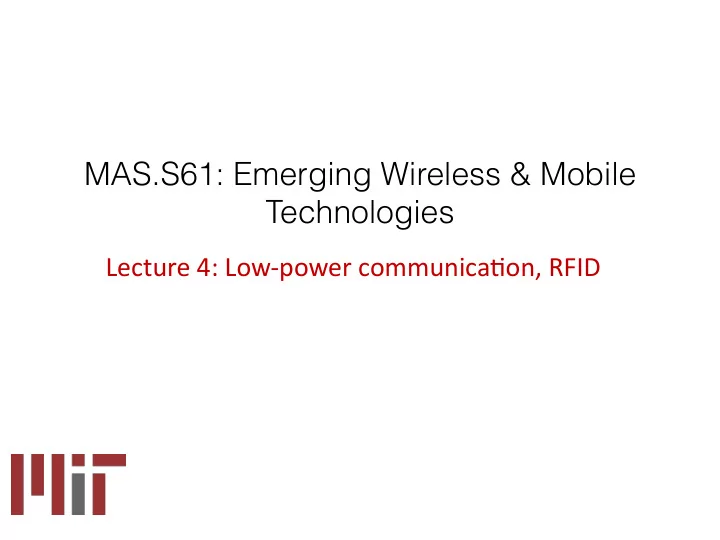

MAS.S61: Emerging Wireless & Mobile Technologies Lecture 4: Low-power communica2on, RFID
RFID (Radio Frequency IDentification) Inventory control Access Control Security Sensitive Applications Tracking & Localization Long-Range Payment Systems
RFID (Radio Frequency IDentification) Inventory control Access Control Security Sensitive Applications > 100 Billion in the world Tracking & Localization Long-Range Payment Systems
Basic Principle of Operation RFID: cheap battery-free stickers Reader Reply to wireless reader with a unique identifier
History of RFIDs • WWII: Aircraft IFF Transponder – Identify Friend or Foe, Transmitter- Responder • 1945: “The Thing” or “The Great Seal Bug” - “Gift” given by the Soviets to American ambassador • 1980s: development of E-Toll transponders • 2004: Auto-ID lab at MIT led to the birth of modern battery-free RFIDs - Goal: supply chain chain optimization - Paper: “Towards the 5 cent tag”
Types of RFIDs Frequency Where do Range these fall? UHF long range (~900MHz) (few m) Range of Operation HF (13.56MHz) short range “need to tap” (few cm) LF (120-150kHz) Power consumption
Types of RFIDs Frequency Range the vast majority of UHF RFIDs (~900MHz) HF Cost (13.56MHz) few cents 10s to 100s Power LF of $ (120-150kHz) consumption Passive Semi-Passive Active (battery-free) or Semi-Active (with battery) Other less common versions: 2.4GHz, UWB (3-10GHz), etc.
In The Rest of This Lecture.. • LF/HF: Power-up / Communicate • UHF: Power-up / Communicate • Medium Access control
How does an RFID power up? Harvests Energy from Reader’s Signal Inductive Coupling Radiative LF UHF HF (120-150kHz) (~900MHz) (13.56MHz) Magnetic Electromagnetic (Near Field) (Far Field) Coil Antenna
Inductive Coupling
Inductive Coupling • Magnetic field also induced in the reverse direction • By modulating its impedance, the tag can communicate bits that are sensed due to the mutual coupling • Where else is this used?
How does the receiver decode? • How does it know whether the high or the low is zero or one? • Training sequence is sent at the beginning is used • Any other type of Near filed operation?
In The Rest of This Lecture.. • LF/HF: Power-up / Communicate • UHF: Power-up / Communicate • Medium Access control
Backscatter Communication • A flashlight emits a beam of light • The light is reflected by the mirror • The intensity of the reflected beam can be associated with a logical “0” or “1” ‘1’ ‘0’
Backscatter Communication
Backscatter Communication Tag reflects the reader’s signal using ON-OFF keying Reader shines an RF signal on nearby RFIDs
Uplink Communication Switch “Off” Switch “On” Power Power Harvester Harvester Switch Switch Controller Controller Antenna Switch
Backscatter Schematic
Demodulation/Harvesting
Demodulation
Power Harvester
Voltage Rectification A rectifier is an electrical device that converts alternating current (AC), which periodically reverses direction, to direct current (DC), which flows in only one direction. Half-wave rectifier Diode Voltage-multiplying rectifiers
Voltage Rectification
Power Harvester
Demodulation Hardware: e: Dem emodulator
Demodulation Hardware: e: Dem emodulator
Demodulation Schmitt Trigger
In The Rest of This Lecture.. • LF/HF: Power-up / Communicate • UHF: Power-up / Communicate • Medium Access control
MAC Single receiver, many transmitters Receiver Transmitter Transmitter Transmitter E.g., Satellite system, wireless
MAC (EPC-Gen 2) Reader Tag Slotted Aloha: – Reader allocates Q time slots and transmits a query at the beginning of each time slot – Each tag picks a random slot and transmits a 16-bit random number – In each slot: RN16 decoded � Reader ACKs � Tags transmits 96-bit ID • Collision � Reader moves on to next slot • No reply � Reader moves on to next slot •
MAC (EPC-Gen 2) Reader Tag Inefficient: – If reader allocates large number of slots � Too many empty slots – If reader allocates small number of slots � Too many collisions
Minimizing Collisions • N RFID Tags & K Time slots • Each tag picks a slot uniformly at random to transmit in • Let’s assume the reader knows the number of tags N; how should it set K? • Probability that a tag transmits in a given slot: • Probability that any tag transmits in a given slot without collision: • To maximize E, set: • p=1/N => K=N
Minimizing Collisions • N RFID Tags & K Time slots • Each tag picks a slot uniformly at random to transmit in • Let’s assume the reader knows the number of tags N; how should it set K? • Probability that a tag transmits in a given slot: • Probability that any tag transmits in a given slot without collision: • p=1/N => K=N
EPC Gen2 – MAC Reader Tag Inefficient: – If reader allocates large number of slots � Too many empty slots – If reader allocates small number of slots � Too many collisions – If reader knows number of tags = N � Allocate K=N slots � 37% efficiency Significant work on “spanning trees”, efficient scanning, decoding with collisions, etc.
In This Lecture.. • LF/HF: Power-up / Communicate • UHF: Power-up / Communicate • Medium Access control
Recommend
More recommend